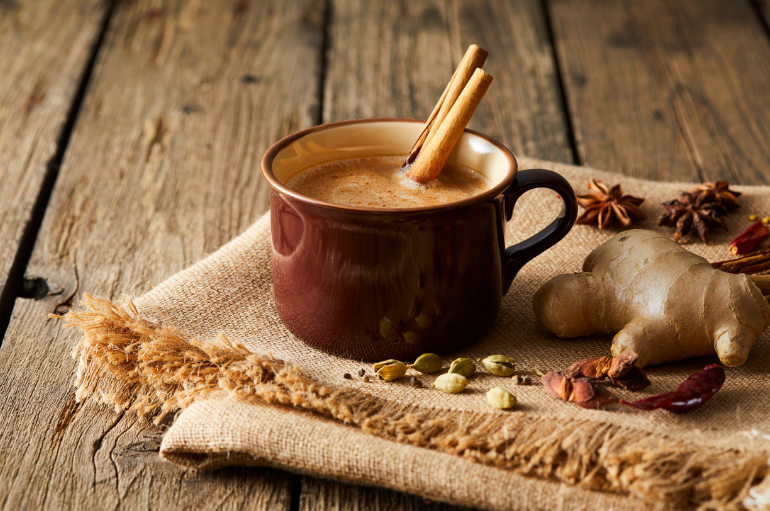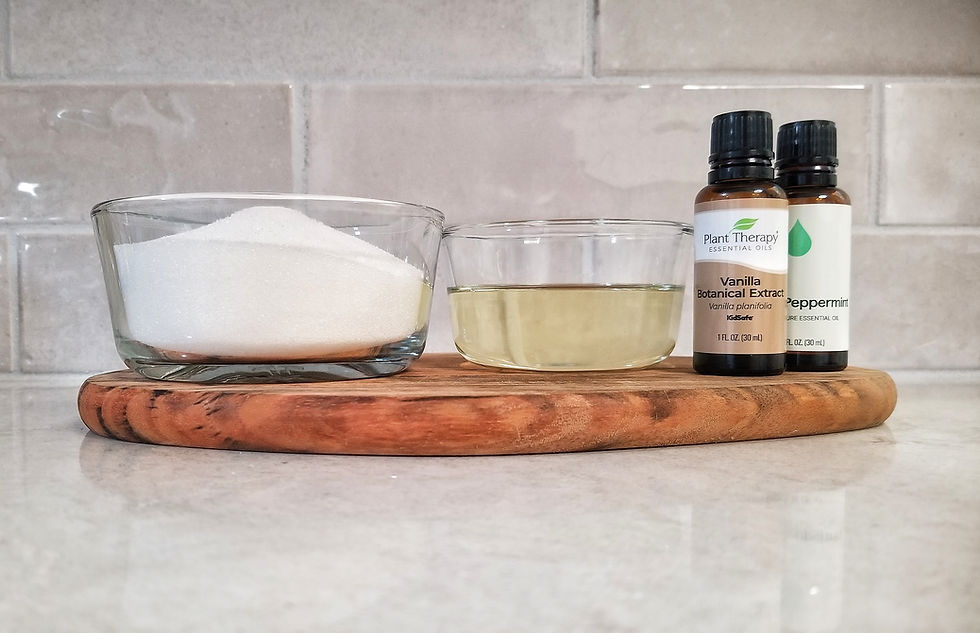Golden Chai: A Celebration of Spices and Wellness
- Jean McCabe
- Aug 28
- 6 min read

Exploring the Tradition, Ingredients, and Benefits of Golden Chai
As the “BER” months approach we want to get cozy and keep warm. Golden Chai can do just that while supporting our body’s immune system during cold and flu season, our digestive system helping digest the heavier winter diet, it also brings anti-inflammatory and antioxidant properties. Let’s dive into Golden Chai.
Introduction
Golden Chai is more than a beverage—it is a warm embrace of ancient wisdom, a vibrant tapestry of flavors, and a gentle elixir crafted from nature’s most celebrated spices and botanicals. Rooted in the traditions of Ayurvedic medicine and South Asian tea culture, Golden Chai is a contemporary evolution of the classic chai, infused with a golden hue and a powerful blend of health-promoting ingredients. Its allure lies not only in the comforting taste but also in the synergy of turmeric, ginger, cinnamon, holy basil, cardamom, black pepper, and rooibos—a combination that awakens the senses and nurtures the spirit.
The Story Behind Golden Chai
Chai, meaning “tea” in Hindi, has long been a staple in Indian households, where it is brewed with black tea, spices, milk, and sweetener. Over centuries, the basic recipe evolved, with regional variations incorporating different spices and herbs. The “golden” aspect of Golden Chai refers to the addition of turmeric—a revered golden root known for its vibrant color and medicinal properties—which transforms traditional chai into an even more healing and restorative drink.
The contemporary rise of Golden Chai coincides with increased global interest in wellness, holistic health, and natural remedies. The blend we explore here is a symphony of seven ingredients, each carefully selected for its unique flavor and health benefits.
The Ingredients: Nature’s Bounty in Every Sip
Turmeric: This golden root is the cornerstone of Golden Chai, imparting its signature color and earthy taste. Turmeric contains curcumin, a compound celebrated for its anti-inflammatory, antioxidant, and immune-boosting properties (Hewlings & Kalman, 2017). In Ayurvedic practice, turmeric is believed to purify the blood and support joint health.
Ginger: Spicy, warming, and invigorating, ginger is a classic chai spice that aids digestion and circulation. The unique compounds in ginger, such as gingerols and shogaols, have been shown to alleviate nausea, reduce inflammation, and provide antimicrobial benefits (White, 2007).
Cinnamon: Sweet and aromatic, cinnamon brings warmth and complexity to the blend. It is valued for its ability to regulate blood sugar, support heart health, and deliver a comforting aroma that soothes the mind (Ranasinghe et al., 2013).
Holy Basil (Tulsi): Known as the “Queen of Herbs” in Ayurveda, holy basil is revered for its adaptogenic qualities. It helps the body cope with stress, enhances mental clarity, and supports immunity (Pattanayak et al., 2010). Tulsi adds refreshing herbal notes to the chai’s profile.
Cardamom: With its floral, citrusy scent, cardamom is a traditional chai spice that aids digestion and freshens breath. It contains antioxidants and is considered beneficial for respiratory health (Verma et al., 2009).
Black Pepper: More than just a seasoning, black pepper plays a critical role in Golden Chai. Piperine, the active compound, increases the bioavailability of curcumin from turmeric, allowing the body to absorb its benefits more efficiently (Shoba et al., 1998). Black pepper also adds an invigorating kick to the blend.
Star Anise: With its distinctive star-shaped pods and licorice-like flavor, star anise adds a subtly sweet and aromatic depth to Golden Chai. Traditionally used in both Ayurvedic and Chinese medicine, star anise is valued for its anti-microbial, anti-inflammatory, and antioxidant properties (Kačániová M et al. 2024). It has been shown to support digestion, help alleviate colds, and contribute to overall respiratory health.
Rooibos: Originating from South Africa, rooibos is a caffeine-free herbal tea with a naturally sweet, earthy taste. It is rich in antioxidants and minerals, making it a healthful base for Golden Chai. Rooibos is known to support heart health, reduce inflammation, and promote relaxation (Joubert & De Beer, 2011).
Making Golden Chai: A Ritual of Wellness
To craft a cup of Golden Chai is to participate in a mindful ritual. The process encourages patience, presence, and appreciation for the bounty of nature. Here is a basic recipe to honor these seven ingredients:
1 teaspoon turmeric, freshly grated or dried
½ teaspoon ginger, freshly grated or dried
½ teaspoon cinnamon chips
½ teaspoon dried holy basil leaves (tulsi)
3-4 crushed cardamom pods (or ½ teaspoon ground cardamom)
¼ teaspoon crushed black peppercorns
1 star anise pod
1 tablespoon rooibos tea leaves
2 cups water (or milk/milk alternative, or a combination of both water and milk, if desired)
Sweetener to taste (honey, maple syrup, or coconut sugar)
Instructions:
Combine all spices and rooibos in a small saucepan.
Add water or milk, or a combination of the two and bring to a gentle simmer for 5-15 minutes. A longer simmer gives you more benefits but does make a stronger tasting tea.
Strain into a cup and add sweetener as desired.
Garnish with a cinnamon stick or a sprinkle of extra turmeric, if you wish.
This process can be adapted to taste—some prefer the earthy intensity of turmeric, others the warming heat of ginger. Experiment with proportions to find your perfect cup.
The Health Benefits: Harmony for Body and Mind
Golden Chai’s ingredients work together to provide a remarkable range of health benefits:
Anti-Inflammatory Power: Turmeric, ginger, cinnamon, star anise and rooibos all possess potent anti-inflammatory properties, which can reduce pain, soothe muscles, and support joint health (Hewlings & Kalman, 2017; White, 2007; Ranasinghe et al., 2013; Joubert & De Beer, 2011).
Antioxidant Support: Rooibos, cinnamon and star anise are high in antioxidants, helping fight oxidative stress and protect the body’s cells (Joubert & De Beer, 2011; Ranasinghe et al., 2013).
Digestive Wellness: Ginger, cardamom, and black pepper support healthy digestion, alleviate bloating, and ease discomfort (White, 2007; Verma et al., 2009; Shoba et al., 1998).
Stress Relief and Adaptogenic Balance: Holy basil helps the body adapt to physical and mental stressors, promoting overall balance and resilience (Pattanayak et al., 2010).
Immune System Boost: The combination of turmeric, tulsi, ginger, and rooibos supports immune health, helping the body defend against illness (Hewlings & Kalman, 2017; Pattanayak et al., 2010; White, 2007; Joubert & De Beer, 2011).
Blood Sugar Regulation: Cinnamon has been shown to help regulate blood sugar, making Golden Chai a wholesome choice for those seeking balance (Ranasinghe et al., 2013).
Enhanced Nutrient Absorption: Black pepper boosts the bioavailability of turmeric’s curcumin, ensuring optimal absorption and efficacy (Shoba et al., 1998).
Caffeine-Free Relaxation: Rooibos provides a comforting, caffeine-free base, making Golden Chai suitable for any time of day (Joubert & De Beer, 2011).
Cultural Significance and Modern Appeal
Golden Chai speaks to a convergence of cultures and healing traditions. Its roots in Ayurveda and Indian chai culture meet the herbal wisdom of southern Africa through rooibos, creating a global blend for modern wellness seekers. The drink’s golden color is symbolic of vitality, enlightenment, and abundance.
Today, Golden Chai is beloved by those seeking alternatives to coffee and black tea, as well as individuals drawn to functional foods and holistic nutrition. It finds its place in cafes, yoga studios, and home kitchens alike, often served hot for comfort, or iced for refreshment.
Variations and Personalization
Golden Chai is endlessly customizable. Sweeteners can be adjusted or omitted according to dietary needs, and vegan options abound. The ritual of making Golden Chai invites creativity and self-care, allowing for personal adaptation while honoring the time-tested foundation of its ingredients. Some popular twists include:
Iced golden chai: Brewed strong and poured over ice for a refreshing summer drink.
Golden chai latte: Frothed plant milk and espresso added for a café-style beverage.
Superfood golden chai: Adding adaptogens like ashwagandha, maca, or reishi mushroom for extra wellness benefits.
Add a dash of nutmeg, cloves, or star anise for additional depth.
Conclusion: Savoring the Golden Moment
Golden Chai is a celebration of nature’s pharmacy, a blend that nourishes both body and soul. Its rich tapestry of flavors and benefits is a testament to the wisdom of tradition and the promise of modern wellness. Whether enjoyed as a morning ritual, an afternoon pick-me-up, or a calming evening treat, Golden Chai offers a golden moment in every cup.
As you sip and savor, let the warmth of turmeric, ginger, cinnamon, holy basil, cardamom, black pepper, and rooibos inspire you. Welcome the gentle embrace of tradition and innovation and celebrate the vibrant health and serenity that Golden Chai brings to your life.
References
Hewlings, S. J., & Kalman, D. S. (2017). Curcumin: A review of its' effects on human health. Foods, 6(10), 92.
Joubert, E., & De Beer, D. (2011). Rooibos (Aspalathus linearis) beyond the farm gate: From herbal tea to potential phytopharmaceutical. South African Journal of Botany, 77(4), 869-886.
Kačániová M, Vukovic NL, Čmiková N, Bianchi A, Garzoli S, Ben Saad R, Ben Hsouna A, Elizondo-Luévano JH, Said-Al Ahl HAH, Hikal WM, Vukic MD. Biological Activity and Phytochemical Characteristics of Star Anise (Illicium verum) Essential Oil and Its Anti-Salmonella Activity on Sous Vide Pumpkin Model. Foods. 2024 May 13;13(10):1505. doi: 10.3390/foods13101505. PMID: 38790803; PMCID: PMC11121629.
Pattanayak, P., et al. (2010). Ocimum sanctum Linn. A reservoir plant for therapeutic applications: An overview. Pharmacognosy Reviews, 4(7), 95-105.
Ranasinghe, P., et al. (2013). The health benefits of cinnamon: a review. Critical Reviews in Food Science and Nutrition, 53(6), 712-728.
Shoba, G., et al. (1998). Influence of piperine on the pharmacokinetics of curcumin in animals and human volunteers. Planta Medica, 64(4), 353-356.
Verma, S. K., et al. (2009). Pharmacological potential of cardamom (Elettaria cardamomum): A review. International Journal of Green Pharmacy, 3(1), 12-17.
White, B. (2007). Ginger: An overview. American Family Physician, 75(11), 1689-1691.




Thank you. Nice explanation. Will be making it.